
A bagel is a bread roll originating in the Jewish communities of Poland. Bagels are traditionally made from yeasted wheat dough that is shaped by hand into a torus or ring, briefly boiled in water, and then baked. The result is a dense, chewy, doughy interior with a browned and sometimes crisp exterior.

Fried rice is a dish of cooked rice that has been stir-fried in a wok or a frying pan and is usually mixed with other ingredients such as eggs, vegetables, seafood, or meat. It is often eaten by itself or as an accompaniment to another dish. Fried rice is a popular component of East Asian, Southeast Asian and certain South Asian cuisines, as well as a staple national dish of Indonesia. As a homemade dish, fried rice is typically made with ingredients left over from other dishes, leading to countless variations. Fried rice first developed during the Sui Dynasty in China.

Lye rolls are a baked specialty in Germany, France (Alsace), Switzerland, and Austria. They are made by immersing bread rolls in a lye solution before baking. The German name, Laugengebäck, is used for any baked good dipped in lye. The perhaps best known shape is the pretzel, while rolls or buns are specifically called Laugensemmel or Kastanie (Bavarian), Laugeweckle or Laugestängle (Swabian), and Laugenwecken, Laugenbrötchen or Laugenstange ; Laugenweckerl in Austria; Silserli or Laugenbrötli in Switzerland. In some parts of Asia they are also known as laugen rolls.
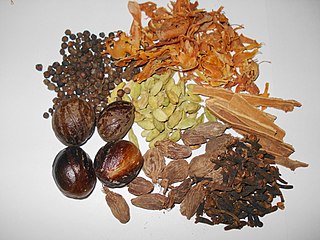
Spice mixes are blended spices or herbs. When a certain combination of herbs or spices is called for in a recipe, it is convenient to blend these ingredients beforehand. Blends such as chili powder, curry powder, herbes de Provence, garlic salt, and other seasoned salts are traditionally sold pre-made by grocers, and sometimes baking blends such as pumpkin pie spice are also available. These spice mixes are also easily made by the home cook for later use.

Bialy, originally from the city of Białystok in Poland, is a traditional bread roll in Polish Ashkenazi Jewish cuisine.
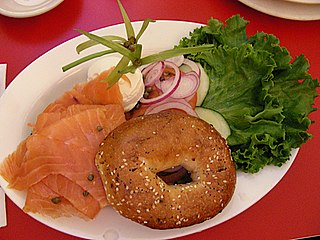
The New York–style bagel is the original style of bagel available in the United States, originating from the Jewish community of New York City, and can trace its origins to the bagels made by the Ashkenazi Jews of Poland.
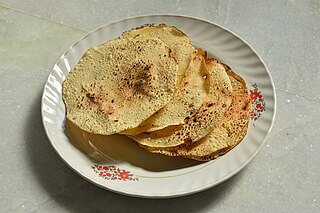
A papadam, also known as papad, is a snack that originated in the Indian subcontinent. Dough of black gram bean flour is either deep fried or cooked with dry heat until crunchy. Other flours made from lentils, chickpeas, rice, tapioca, millet or potato are also used. Papadam is typically served as an accompaniment to a meal in India, Pakistan, Bangladesh, Nepal, Sri Lanka and the Caribbean or as an appetizer, often with a dip such as chutneys, or toppings such as chopped onions and chili peppers, or it may be used as an ingredient in curries.

Czech cuisine has both influenced and been influenced by the cuisines of surrounding countries and nations. Many of the cakes and pastries that are popular in Central Europe originated within the Czech lands. Contemporary Czech cuisine is more meat-based than in previous periods; the current abundance of farmable meat has enriched its presence in regional cuisine. Traditionally, meat has been reserved for once-weekly consumption, typically on weekends.

Simit or rosquilla is a circular bread, typically encrusted with sesame seeds or, less commonly, poppy, flax or sunflower seeds, found across the cuisines of the former Ottoman Empire and the Middle East, especially in Armenia, Turkey and the Balkans. Simit's size, crunch, chewiness, and other characteristics vary slightly by region.

Levantine cuisine is the traditional cuisine of the Levant, in the sense of the rough area of former Ottoman Syria. The cuisine has similarities with Egyptian cuisine, North African cuisine and Ottoman cuisine. It is particularly known for its meze spreads of hot and cold dishes, most notably among them ful medames, hummus, tabbouleh and baba ghanoush, accompanied by bread.

Bourekas or burekas are a popular baked pastry in Sephardic Jewish cuisine and Israeli cuisine. A variation of the burek, a popular pastry throughout southern Europe, northern Africa and the Middle East, Israeli bourekas are made in a wide variety of shapes and a vast selection of fillings, and are typically made with either puff pastry, filo dough, or brik pastry, depending on the origin of the baker.

Manakish, or in singular form man'ousheh, or other spellings, is a popular Levantine food consisting of dough topped with za'atar, cheese, or ground meat. It can be sliced or folded, and it can be served either for breakfast or lunch.
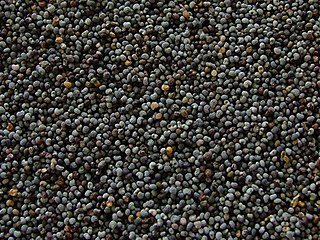
Poppy seed is an oilseed obtained from the opium poppy. The tiny, kidney-shaped seeds have been harvested from dried seed pods by various civilizations for thousands of years. It is still widely used in many countries, especially in Central Europe and South Asia, where it is legally grown and sold in shops. The seeds are used whole or ground into meal as an ingredient in many foods – especially in pastry and bread – and they are pressed to yield poppyseed oil.

A bagel dog is a food item consisting of a full-size or miniature hot dog wrapped in bagel-style breading before or after cooking. They are similar in concept to a corn dog or pigs in a blanket. Bagel dogs are commonly available for purchase at prepared-food concession stands and frozen in grocery stores in the greater New York City, Chicago, and Cincinnati areas, but are more difficult to find elsewhere. Some bagel dogs are prepared using an actual bagel to wrap around the hot dog, rather than a bagel-like breading.

Taralli are toroidal Italian snack foods, common in the southern half of the Italian Peninsula. A wheat-based cracker similar in texture to a grissini breadstick, taralli can be sweet or savory. Sweet taralli are sometimes glazed with sugar. Savory taralli may be flavored with onion, garlic, sesame seeds, poppy seeds, fennel, pepper, chili or just salt. Sweet and plain taralli are often dunked in wine.

Fairmount Bagel is a Montreal-style bagel bakery in Montreal, Quebec, Canada in the Mile End neighbourhood of the Plateau-Mont-Royal borough. The first location opened on September 7, 1919 on Saint-Laurent Boulevard by Isadore Shlafman. The current location, on 74 Fairmount Avenue West was opened in 1949. Fairmount Bagel remains a family-run business.

St-Viateur Bagel is a famous Montreal-style bagel bakery located in the neighbourhood of Mile End in the borough of Le Plateau-Mont-Royal, Montreal, Quebec, Canada.
Brandon Steiner is a sports marketer. He was the founder and former CEO of Steiner Sports now owned by Fanatics. He is currently the founder and CEO of CollectibleXchange and The Steiner Agency. He and his family live in Scarsdale, New York.

Burmese salads are a diverse category of indigenous salads in Burmese cuisine. Burmese salads are made of cooked and raw ingredients that are mixed by hand to combine and balance a wide-ranging array of flavors and textures. Burmese salads are eaten as standalone snacks, as side dishes paired with Burmese curries, and as entrees. The iconic laphet thoke is traditionally eaten as a palate cleanser at the end of a meal.
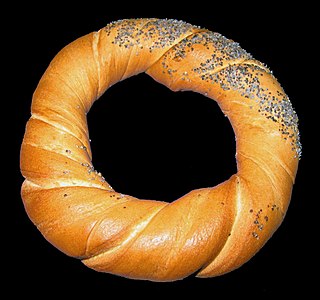
An obwarzanek krakowski is a braided ring-shaped bread that is boiled and sprinkled with salt and sesame or poppy seeds before being baked. It has a white, sweetish, moist and chewy crumb underneath a crunchy golden-brown crust. Traditionally sold from street carts, it is a popular snack in the Polish city of Kraków, where it has the status of a regional food with protected geographical indication. It is closely related to, but distinct from, bagels, bubliks and pretzels.


















